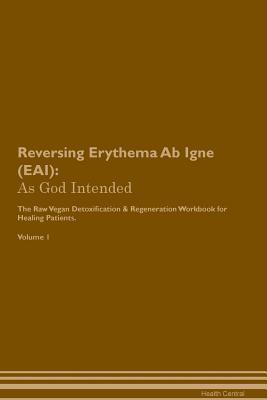Download Reversing Erythema Ab Igne (EAI): As God Intended The Raw Vegan Plant-Based Detoxification & Regeneration Workbook for Healing Patients. Volume 1 - Health Central file in PDF
Related searches:
Working from home during and after COVID-19: watch out for
Reversing Erythema Ab Igne (EAI): As God Intended The Raw Vegan Plant-Based Detoxification & Regeneration Workbook for Healing Patients. Volume 1
Erythema ab igne (eai) is a reticulate hypermelanosis with erythema resulting from repeated heat exposure that induces injury to the epidermis and superficial vascular plexus. The exposure, which need not be of long duration, results in cutaneous hyperthermia in the range of 43-47°c.
There is no specific therapy for eai, but the initial stages may be reversible if the heat source (table i) is eliminated.
Erythema ab igne is a skin condition that is caused by long term exposure to heat. It is often referred to as hot water bottle rash, laptop thigh, granny’s tartan, toasted skin syndrome or fire stains. It is an uncommon skin disorder that has a fish net like pattern of hyper pigmentation on the skin.
A diagnosis of erythema ab igne (eai) or toasted skin syndrome is rendered (figure 90-1). Figure 90-1 highly illustrative case of the irregular, net-like hyperpigmentation of erythema ab igne (eia) along the entire back of a patient with chronic back pain.
Erythema ab igne is an uncommon condition manifesting in a reticulated, or fishnet-like, pattern of hyperpigmentation on the skin resulting from chronic exposure to low-levels of heat or infrared radiation. The name comes from latin and can be translated ‘redness from fire’.
Toasted skin syndrome, known as erythema ab igne or eai, is caused by exposure to heat, although it is not a burn. There have been few cases of people being scorched by car seats that.
A clinical diagnosis of erythema ab igne (eai) was made, and the patient confirmed the frequent use of a hot water bottle to alleviate abdominal discomfort continuously overnight for 4 weeks. She was advised to discontinue using her heating bottle, and the cutaneous findings slowly improved, with complete resolution after 6 months.
25 sep 2019 erythema ab igne (eai) is an atypical cutaneous disorder that. Can occur in various situations eai is a benign transient condition which is mainly reversible� after the treasure island (fl):statpearls publishing.
Erythema ab igne is a reticulated erythematous eruption resulting in hyperpigmentation that occurs in the setting of chronic thermal exposure. 1, 2 classically, it is found to occur on the shins of elderly patients who spend time in close proximity to open heating sources, and its incidence has been greatly reduced with the advent of centralized heating.
Erythema ab igne (eai) has not been common since coal stoves have no longer been in general use for heating. Nevertheless, each winter several patients with macular-reticular skin lesions considered to be eai are seen in our clinic.
A diagnosis of erythema ab igne (eai) or “toasted skin syndrome” is rendered (figure 90-1). Figure 90-1 highly illustrative case of the irregular, net-like hyperpigmentation of erythema ab igne (eia) along the entire back of a patient with chronic back pain.
Erythema ab igne (eai) presents as an erythema-tous, reticular, net-like dermatosis that develops due to chronic exposure to low level thermal heat. 1,2,3,4 while contact dermatitis can also occur after contact with a foreign substance, it develops an irritant or allergic reaction.
Erythema ab igne (eai) is a skin reaction caused by chronic exposure to infrared radiation in the form of heat.
Erythema ab igne (eai) is a rare condition since the advent of central heating. Its incidence has been rising as heating sources are being used to treat chronic pain. Multiple activities that chronically expose patients to heating sources also have been documented with this condition. We present a case of eai induced by the use of an electric blanket.
Erythema ab igne (eai), also known as hot water bottle rash, is a skin condition caused by long-term exposure to heat (infrared radiation). Prolonged thermal radiation exposure to the skin can lead to the development of reticulated erythema, hyperpigmentation, scaling and telangiectasias in the affected area.
Erythema ab igne (eai) is a skin reaction caused by chronic exposure to infrared radiation in the form of heat. It was once a common condition seen in the elderly who stood or sat closely to open fires or electric space heaters.
Erythema ab igne (eai) is a skin reaction characterised by a pattern of erythema (redness) resembling a net or hyperpigmentation (increased pigmentation) caused by chronic exposure to heat. In the past, eai most commonly affected people who spent excessive time in front of stoves, open fires and space heaters.
Erythema ab igne (eai) is an asymptomatic dermatosis that develops in response to chronic exposure to low‐grade heat. Characteristic findings on histopathology include epidermal atrophy, dermal elastosis, atypical histiocytes, and melanin and hemosiderin deposition. Reactive endothelial changes and prominent vascular proliferation are variable.
What is the abbreviation for erythema ab igne? what does eai stand for? eai abbreviation stands for erythema ab igne.
18 jul 2017 erythema ab igne (eai), also known as “toasted skin syndrome” and “fire stains”, is a localised, cutaneous condition, consisting of reticulate.
Erythema ab igne (eai) is a persistent, chronic skin condition resulting from prolonged exposure to infrared radiation, experienced as heat.
For many, this transition to working more at home is unlikely to be reversed for many post-pandemic. The infrared radiation emitted can cause erythema ab igne (eai) — someti.
Reducing or eliminating exposure to the heat source early in the erythema ab igne disease process may reverse the hyperpigmentation.

Post Your Comments: